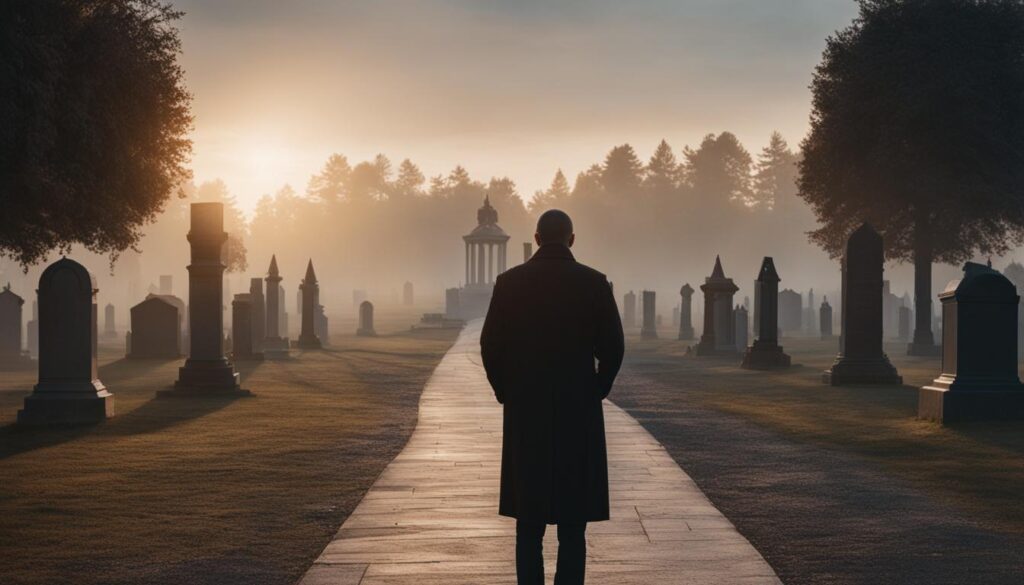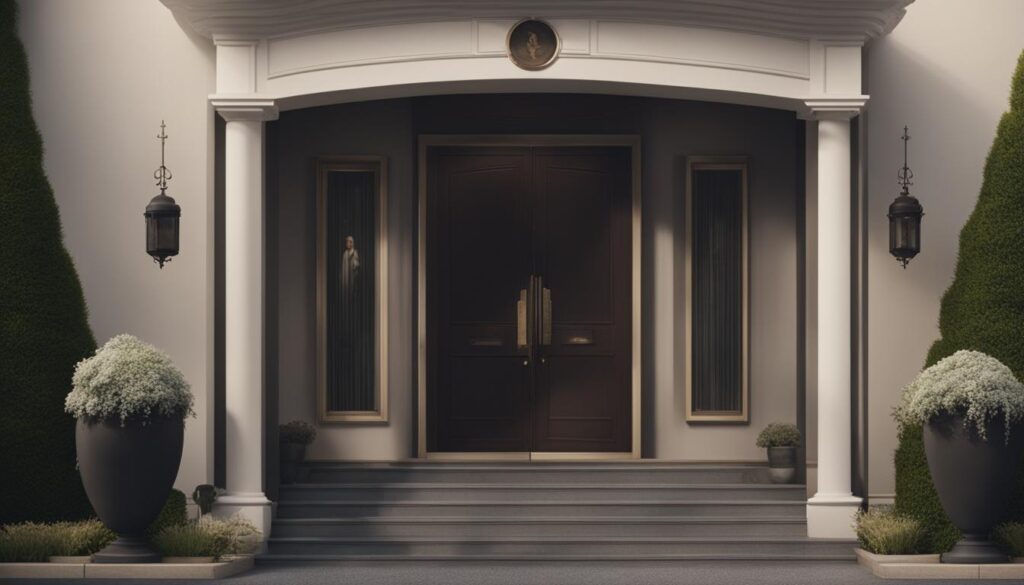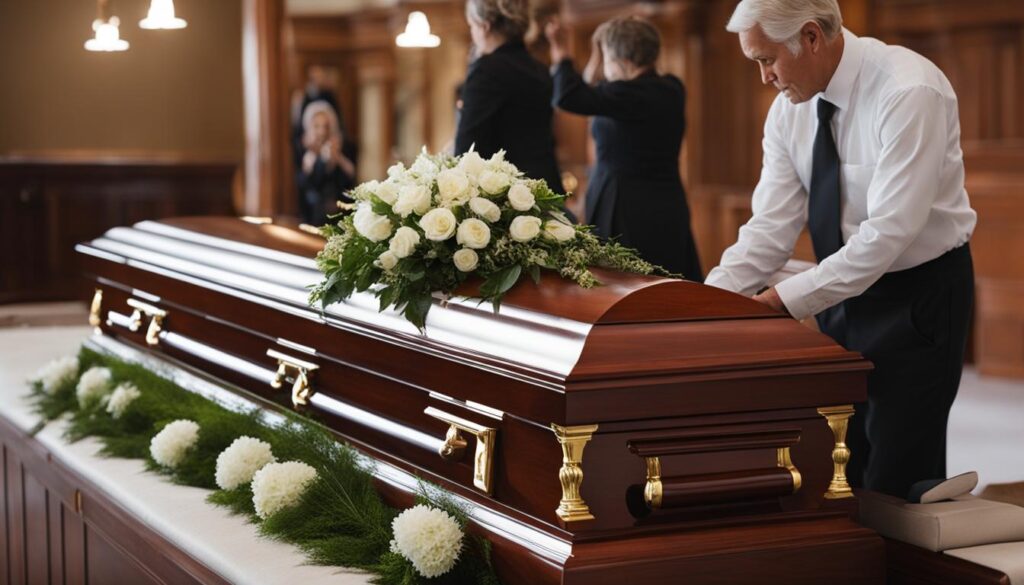We may earn money or products from the companies mentioned in this post.
Choosing between burial and cremation is an important decision that requires careful consideration. While both options offer unique benefits and drawbacks, the choice ultimately boils down to personal beliefs, preferences, and budget.
In this section, we will dive into the details of burial vs cremation options, compare burial and cremation, and discuss funeral planning choices to help you make an informed decision that aligns with your needs and values.
Key Takeaways
- The decision between burial and cremation is a personal one that requires careful consideration.
- Both burial and cremation offer unique benefits and drawbacks that should be weighed against your beliefs, preferences, and budget.
- There are various funeral planning choices available, including traditional burial, cremation services, and eco-friendly funeral options.
- Comparing burial and cremation involves factors such as cost, environmental impact, religious considerations, and personal beliefs.
- An informed decision takes into account all relevant factors and honors the memory of your loved one.
Traditional Burial: A Time-Honored Choice
Traditional burial is a popular option for many people when it comes to funeral planning. It involves burying the body in a casket in a cemetery or a burial plot. Let’s explore the benefits of choosing traditional burial over cremation.
Emotional Significance
One of the significant benefits of traditional burial is the emotional significance it holds. It provides a tangible location where loved ones can visit and pay respect to the deceased. A burial plot can serve as a place of solace for friends and family who wish to feel close to their loved one after they have passed away.
Honoring Customs and Traditions
Traditional burial allows families to honor customs and traditions that have been passed down for generations. Many cultures believe that burying the body of the deceased is crucial for their spiritual journey. It provides a sense of closure and a way for families to respect their traditions.
Cemetery Options
When choosing traditional burial, families have a wide variety of cemetery options available to them. They can choose a cemetery based on proximity to their home, religious affiliation, or personal preference. Some cemeteries offer various landscaping features, such as gardens, ponds, or fountains, which can create a tranquil and peaceful environment for loved ones.
| Benefits of Traditional Burial | |
|---|---|
| Emotional significance | Honoring customs and traditions |
| Cemetery options |
“Traditional burial provides a tangible location where loved ones can visit and pay respect to the deceased.”
In conclusion, traditional burial holds significant value for many families who value honoring customs and traditions, emotional significance, and the availability of cemetery options. While it may be more costly than cremation, it can provide a sense of closure and comfort for loved ones left behind.
Cremation Services: An Alternative Approach
While traditional burial has been a common choice for many years, cremation is becoming an increasingly popular alternative. Cremation services offer unique benefits that may align with your beliefs, budget, and personal preferences.
During the cremation process, the body is reduced to its basic elements through intense heat and evaporation. The resulting remains, known as cremains, can be memorialized in various ways.
One significant advantage of cremation is the flexibility it provides. Unlike traditional burial, cremation allows individuals to choose from a range of memorialization options, including:
- Cremation urns: Cremains are stored in a decorative urn, which can be displayed in the home, placed in a columbarium niche, or buried in a cemetery plot.
- Cremation jewelry: A small portion of the cremains can be placed in a piece of jewelry, such as a pendant or bracelet, providing a wearable keepsake.
- Scattering: The cremains can be scattered in a meaningful location, such as a favorite park or the ocean. Some individuals choose to have their ashes scattered via a special ceremony, such as a balloon release or ash scattering service.
Another advantage of cremation is the cost. Cremation services are typically less expensive than traditional burials, as they do not require the purchase of a casket, cemetery plot, or headstone. However, it’s important to note that additional costs may be incurred if you choose to memorialize the remains in a specific way.
Finally, cremation is considered to be more environmentally friendly than traditional burial. The process requires less land and does not involve embalming fluids or other chemicals that may harm the environment. Some cremation providers also offer eco-conscious options, such as biodegradable urns or water cremation, which uses water instead of fire to cremate the body.
It’s important to carefully consider the different options available when it comes to burial and cremation. By weighing the advantages and disadvantages of each approach, you can make an informed decision that aligns with your beliefs and values.
Comparing Burial and Cremation: Factors to Consider
Choosing between burial and cremation can be a difficult decision. To make an informed choice, it’s essential to consider various factors. Here, we will compare burial and cremation options and discuss the benefits and advantages of each choice.
Cost
Cost is a significant factor to consider when choosing between burial and cremation. Generally, cremation is more affordable than burial. While the cost of a traditional funeral service with burial can range from $7,000 to $10,000, a basic cremation service can cost as little as $1,000 to $3,000. It’s important to note that costs can vary depending on the location, funeral home, and additional services chosen.
Environmental Impact
Another consideration when comparing burial and cremation is their impact on the environment. Traditional burial methods require the use of a burial plot, casket, and embalming, which can have negative effects on the environment. In contrast, cremation involves high temperatures that release pollutants into the air. However, new eco-conscious cremation practices are becoming available, utilizing water and reducing carbon emissions.
Personal Beliefs and Preferences
Personal beliefs and preferences should also be considered when deciding between burial and cremation. Burial may align better with certain religious traditions and cultural practices, while cremation may be favored by those who value simplicity or have environmental concerns. It’s important to discuss your beliefs and preferences with family members to better understand their opinions and needs.
Memorialization
When considering burial vs cremation options, it’s essential to think about how you want to memorialize your loved one. Burial offers physical, tangible gravesites that can be visited by family and friends, while cremation offers a range of unique memorialization options such as scattering the ashes or creating a memorial tree.
Emotional Impact
Finally, the emotional impact of burial vs cremation options should not be overlooked. Traditional burial practices can provide loved ones with closure and a sense of peace. Cremation, meanwhile, can be a more emotional experience, requiring family members to make decisions about the final disposition of the remains.
Comparing burial and cremation options involves considering various factors, including cost, environmental impact, personal beliefs and preferences, memorialization, and emotional impact. By weighing these factors, you can make an informed choice that aligns with your values and honors your loved one’s memory.
Cost of Burial vs Cremation: Analyzing the Financial Aspect
The cost of funeral services can vary greatly depending on the location, type of service, and personal preferences of the individual or their family. When considering the financial aspect of burial vs cremation, it’s important to take into account all associated costs.
Funeral Services
The cost of funeral services can differ significantly between burial and cremation options. According to the National Funeral Directors Association, the average cost of a funeral with viewing and burial in 2019 was $9,135, while the average cost of a funeral with viewing and cremation was $7,640. However, these costs can vary depending on the location and specific funeral home.
It is important to consider that with a traditional burial, additional costs such as cemetery plot, headstone, and grave liner may apply. These expenses can range from a few thousand dollars to tens of thousands of dollars, depending on the location and cemetery.
Cremation Costs
While cremation may be more affordable than traditional burial, it’s important to understand that cost can vary depending on the type of cremation chosen. The average cost of a direct cremation (without a formal funeral service) is around $1,000 to $3,000, while a cremation with a funeral service can range from $2,000 to $6,000.
Comparing Costs
When comparing the cost of burial vs cremation, it’s essential to take into account all associated costs. While cremation may seem like a more cost-effective option, it’s important to understand that additional memorialization options such as an urn or scattering service may incur additional expenses.
Overall, the cost of funeral services can add up quickly, so it’s best to plan ahead and compare options for both burial and cremation to make an informed decision that aligns with your budget.
Eco-Friendly Funeral Options: Considering the Environment
With environmental concerns growing, many individuals are seeking eco-friendly funeral options that reduce their carbon footprint. When deciding between burial and cremation, it is important to consider the environmental impact of each option. Here is a comparison:
| Environmental Impact | Burial | Cremation |
|---|---|---|
| Land Usage | Requires land for burial plots, which can contribute to deforestation and fragmentation of wildlife habitats. | Does not require land for burial plots, but emissions produced by the cremation process can contribute to air pollution. |
| Carbon Footprint | Embalming fluid used in traditional burial can contain toxic chemicals that seep into groundwater. The production and transportation of caskets and headstones also contribute to carbon emissions. | Requires the burning of fossil fuels, such as natural gas, to reach the high temperatures required for the cremation process. |
| Alternative Options | Green burials that use biodegradable materials and avoid embalming fluids can reduce the environmental impact of burial. | Water or alkaline hydrolysis cremation uses less energy and produces fewer emissions than traditional cremation. |
While cremation may have a smaller environmental impact, there are eco-friendly burial options available. In a green burial, the body is typically not embalmed and a biodegradable casket or shroud is used. Natural burial sites are also becoming more popular, where the grave is dug without a liner or vault to allow for natural decomposition and to return the body to the earth. Trees or other vegetation can be planted on the gravesite to help offset carbon emissions.
Ultimately, the choice between burial and cremation depends on personal beliefs, values, and preferences. However, it is important to consider the environmental impact of your decision to ensure that your final goodbye also honors the planet.
Making an Informed Decision: Factors Beyond Tradition and Cost
Choosing between burial and cremation is a personal decision that should take into account various factors. There are other considerations, beyond tradition and cost, that can help you make the right choice for you and your family. In this section, we will explore some additional factors to consider when making this important decision.
Funeral Planning Choices
Whether you choose burial or cremation, there are many different funeral planning choices to consider. You can opt for a traditional funeral service, a memorial service, or a celebration of life. You can also choose to have the service at a funeral home, a place of worship, or a special location that holds significance for you and your loved one.
When planning the service, consider your loved one’s personality and values. You can personalize the service with special readings, music, or videos that reflect their life and legacy. This can offer comfort and support to your family and friends during the grieving process.
Compare Burial and Cremation
When comparing burial and cremation, there are many different factors to consider beyond cost. It is important to think about your loved one’s wishes and cultural or religious customs. Burial is a traditional option that provides a physical location for loved ones to visit and pay their respects. Cremation is an increasingly popular option that offers flexibility in terms of memorialization and allows loved ones to keep the remains close to them.
Other factors to consider when comparing burial and cremation include environmental impact and personal preferences. Burial requires a cemetery plot, which can impact the environment. Cremation emits carbon dioxide and other pollutants into the atmosphere. If you are environmentally conscious, you may want to consider alternative green burial methods or eco-conscious cremation practices.
Personal Beliefs and Cultural Customs
Personal beliefs and cultural customs can also play a significant role in the decision between burial and cremation. Some religions, such as Catholicism and Judaism, require burial. Other religions, such as Hinduism and Buddhism, prefer cremation. It is important to consult with religious leaders or advisors to understand the customs and beliefs of your faith.
Personal beliefs and preferences should also be considered. Some individuals may prefer the idea of being buried in a specific location or being cremated and their ashes scattered in a meaningful place. These factors should be taken into account when making the decision between burial and cremation.
The Emotional Impact on Loved Ones
Finally, it is important to consider the emotional impact on loved ones when making the decision between burial and cremation. The grieving process can be difficult, and the funeral or memorial service can provide closure and comfort to family and friends. Consider how the choice of burial or cremation will impact your loved ones and their ability to mourn and heal.
In conclusion, the decision between burial and cremation is a deeply personal one that requires careful consideration. By exploring funeral planning choices, comparing burial and cremation options, taking personal beliefs and cultural customs into account, and considering the emotional impact on loved ones, you can make an informed decision that honors your loved one’s memory.
Conclusion
Choosing between burial and cremation is a significant decision that requires careful consideration. By exploring the different options available and weighing the pros and cons of each, you can make an informed choice that aligns with your beliefs and budget.
Factors to Consider
Factors beyond tradition and cost should also be taken into account. Personal beliefs, cultural customs, religious practices, and the emotional impact on loved ones are all essential considerations when making this decision. It’s important to choose a funeral option that honors the memory of your loved one while also providing closure and comfort to those left behind.
Make an Informed Choice
Whether you choose burial or cremation, it’s important to understand the financial implications of your decision. By breaking down the costs associated with each option, you can make an informed choice that aligns with your budget.
Additionally, with growing environmental concerns, many individuals are seeking eco-friendly funeral options. By exploring alternative green burial methods and eco-conscious cremation practices, you can ensure that your final farewell aligns with your commitment to the environment.
Final Thoughts
Ultimately, the decision between burial and cremation is a personal one that should reflect your beliefs, preferences, and circumstances. By considering all of the factors and exploring your options, you can make an informed decision that honors your loved one’s memory and provides comfort and closure to those left behind.
So, whether you choose burial or cremation, remember to take your time, and make the decision that feels right for you and your family.
Remember to compare burial and cremation options to help you make an informed decision.
FAQ
What are the options available for burial vs cremation?
The options available include traditional burial and cremation services.
What is traditional burial?
Traditional burial involves interring the deceased’s body in a cemetery plot.
What is involved in the burial process?
The burial process typically includes preparing the body, holding a funeral service, and interring the casket in a grave.
What are the advantages of traditional burial?
Traditional burial allows for a physical location for visitation and memorialization.
What are cremation services?
Cremation services involve the process of reducing the deceased’s body to ashes through intense heat.
How can cremated remains be memorialized?
Cremated remains can be stored in urns, scattered in meaningful locations, or used for creating memorial jewelry or keepsakes.
What are the advantages of choosing cremation?
Cremation offers flexibility in memorialization options, including cost savings compared to traditional burial.
What factors should I consider when comparing burial and cremation?
Factors to consider include cost, environmental impact, religious considerations, and personal preferences.
How does the cost compare between burial and cremation?
Costs associated with burial include funeral services, cemetery plots, and memorialization, while cremation generally has lower overall expenses.
Are there eco-friendly funeral options available?
Yes, there are eco-friendly options such as green burial methods and environmentally conscious cremation practices.
What factors beyond tradition and cost should be considered?
Other factors to consider include personal beliefs, cultural customs, religious practices, and the emotional impact on loved ones.
How can I make an informed decision between burial and cremation?
By understanding the available options, considering your beliefs, budget, and environmental concerns, you can make a decision that honors your loved one’s memory.
Affiliate Disclosure: This post may contain affiliate links. If you purchase through our link, we may receive a small commission, but at no additional cost to you. For more information, please see our Disclosure statement.



